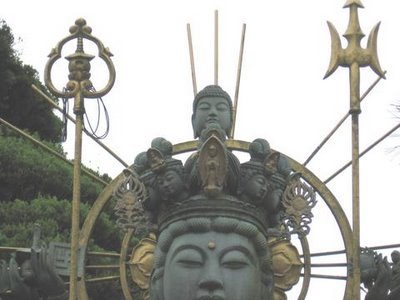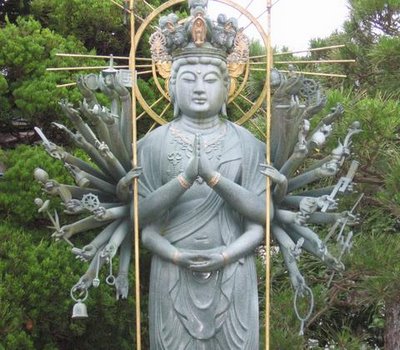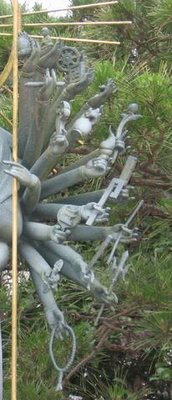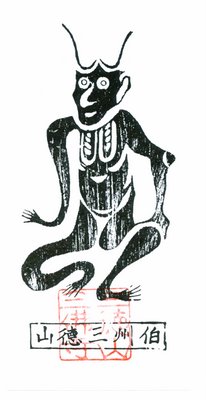:::::::::::::::::::::::::::::::::::::::::::::::::::::::::::::::::::::::::::::::::::::::::::::::::::::
Sokushinbutsu, the Living Mummies of Japan
Miira 即身仏のミイラ
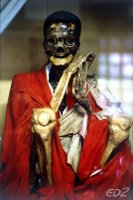
PHOTO source: wordpress.com
! My Album with the Photos !
! Photos on the Internet !
:::::::::::::::::::::::::::::::::::::::::::::::::::::::::::::::::::::::::::::::::::::::::::::::::::::
Buddhist Mummies of Japan
This subject brings us to the fringes of ascetic Buddhist practises and is only for the advanced reader. Some of them in the tradition of Kuukai, Kooboo Daishi 空海received the name of xxKAI, as you can see in the list below. Differing from Egyptian mummies who are prepared after death, these Holy Man prepare their body while alive in a long ascetic practise for keeping in eternity.
QUOTE
Estimates of the number of self-mummified priests in Japan range between sixteen and twenty-four priests. Impressive though this number is, many more have tried to self-mummify themselves; In fact, the practice of self-mummification -- which is a form of suicide, after all -- had to be outlawed towards the end of the 19th century to prevent Buddhist priests from offing themselves this way... and yet the grand majority of priests who have tried to do this have failed. The reasons will take some explaining -- but first, some background on the whole practice and the reasons for it.
So truely devote Buddhist priests are not afraid of death; but they don't normally seek it either, as this too would be an abnormal obsession with the physical world. The priests that chose to practice self-mummification were usually all older men, who knew they had limited time left to their lives anyway... and since the practice takes years to lead to a sucessful death and mummification, it cannot be characterized as an attempt to reach enlightenment quickly as a normal suicide might be. Rather, the intended purpose of this practice for these priests is to both push their ability to disregard their physical selves to the limit of their ability, and to try and leave an artifact of this struggle that will stand as a symbol of their beliefs to those that are priests after them.
How to be a self-made mummify
Scientific study of the mummies and the process that created them only began in the early 1960's. It was generally expected that the mummies studied would show signs of having been mummified after death by other priests, in much the way Egyptian mummies -- and almost all other mummies on Earth -- have been created. The first step in that process is the removal of the internal organs, because the bacteria in these begin the process of decomposition within hours of death; with these removed, it is relatively easy to prepare, dry, and preserve the remainder of the body. But x-rays discounted this expectation... the internal organs were intact, which meant that mummification had been accomplished in some new way that scientists had not yet encountered. So the process itself was next investigated.
The actual practice was first pioneered by a priest named Kuukai over 1000 years ago at the temple complex of Mount Kooya, in Wakayama prefecture. Kuukai was founder of the Shingon sect of Buddhism, which is the sect that came up with the idea of enlightenment through physical punishment. There were three steps in the process of self-mummification that Kuukai proposed, and the full process took upwards of ten years to lead to a successful mummification.
The first step is a change of diet. The priest was only allowed to eat nuts and seeds that could be found in the forests surrounding his temple; this diet had to be stuck to for a 1000 day period, a little under three years. During this time, the priest was to continue to subject himself to all sorts of physical hardship in his daily training. The results were that the body fat of the priest was reduced to nearly nothing, thus removing a section of the body that easily decomposes after death.
In the second stage, the diet became more restrictive. The priest was now only allowed to eat a small amount of bark and roots from pine trees (mokujiki). This had to be endured for another 1000 day period, by the end of which the priest looked like a living skeleton. This also decreased the overall moisture contained in the body; and the less fluid left in the body, the easier to preserve it.
Towards the end of this 1000 day period, the priest also had to start to drink a special tea made from the sap of the urushi tree. This sap is used to make laquer for bowls and furniture; but it is also very poisonous for most people. Drinking this tea induced vomenting, sweating, and urination, further reducing the fluid content of the priest's body. But even more importantly, the build up of the poison in the priest's body would kill any maggots or insects that tried to eat the priest's remains after death, thus protecting it from yet another source of decay.
The third and last step of the process was to be entombed alive in a stone room just big enough for a man to sit lotus style in for a final 1000 day period. As long as the priest could ring a bell each day a tube remained in place to supply air; but when the bell finally stopped, the tube was removed and the tomb was sealed.
When the tomb was finally opened, the results would be known. Some few would be fully mummified, and immediately be raised to the rank of Buddha; but most just rotted and, while respected for their incredible endurance, were not considered to be Buddhas. These were simply sealed back into their tombs. But why did some mummify and some not? This is the tricky part of the whole process.
It is not clear if this is part of the process as set down by Kuukai, but in Yamagata is a sacred spring. This spring is on a mountain called Yudono, which is in fact the third sacred mountain of the three I visited in 1998. Many of the priests in the area considered both the water and the mineral deposits from this spring to have medicinal value, and may have injested one or both previous to their entombment. An analysis of the spring water and deposits revealed that they contain enough arsenic to kill a human being! Arsenic does not get eliminated from the body, so it remains after death... and it is toxic to bacteria and other micro-organisms, so it eliminated the bacteria that started the decompostion of the body.
As you can see, the process of self-mummification was a long and extremely painful process that required a mastery of self-control and denial of physical sensation. The self-made mummies of Japan are people who have earned the respect now shown to them, as they exemplify the teachings of the Shingon sect of Japanese Buddhism.
http://www.sonic.net/~anomaly/japan/dbuddha.htm
Daruma Library
:::::::::::::::::::::::::::::::::::::::::::::::::::::::::::::::::::::::::::::::::::::::::::::::::::::
Now read a short report of my travels in the area.
! My Album with the Photos ! Use this for the pictures
In May 1993, we took to the small roads of Northern Japan in pursuit of some of the living mumies.
On the sea-side of Mt. Yahikoyama 弥彦山 (the land-side shelters the temple Kokkujoo-ji, where Ryokan used to live in the small hut Gogoo-an), anyway, on the other side of this holy mountain, the temple Saishoo-ji is located halfway up the mountain.
They seem to make a good business with the sacred mummy, already from far a way many roadsigns lead us easily to the huge parking space. The Holy Koochi Hooin 弘智法印is sitting here, said to be the oldeset mummy, since 1363. He has his own special hall and sits there hanging slightly to the front, since a samurai, who was afraid of the whole business of living mumies, stuck a spear in his shoulder. (see picture). This samurai in turn had to leave his head for the unholy act, another trophy shown in this temple compound.
001 Picture Koochi getting stabbed
002 Picture Koochi fallen over after the lance blow
003 Picture His memorial stone
Three tourist busses have come this morning and we follow the busy head priest, leading us on with his megaphone, past a huge statue of the Holy Koochi towards the small hall. Ther he rings a bell, says a prayer in high-speed and then openes a brocade veil which had covered the Sacred Mummy. Now we can look at him, behind some clouds of incense. His body is there in full presence, getting dressed for the season twice a year. His body is unpalatable for the mice and does not react to heat or moisture any more. So he is sitting there since more than 600 years and receives the prayers of the believers with great magnanimity. Some of the people from the bus tour tell me they come here every year to “receive some strength”.
Well, after this busybody morning we take off along the coast, further north. I leave out our other adventures here and concentrate on the Sacred Mummies. (Details of all Holy men see below)
We reach the small town of Murakami and try to locate the Kannon Temple, but this time no signs and no megaphones…
After cruising around the station area for a while we find an unconspicious house-like temple. The priest seems surprised that someone shows up. He was cleaning the clean wooden planks of his temple and openes after I ring the bell many times to ask for permisison to come in.
He is very friendly and shows us to the small side-altar of the Holy Bukkai, who is sitting there since 1903. Even after the abolishment of this old tradition, he finished his ascetic practises and entered his final box only to be living on here now for ever. There is even a photo of an old man with a long beard beside the altar, showing the real living person. This is a place for the serious pilgrim only. Nobody disturbs our encounter here.
Next we are heading toward the three holy mountains of Dewa, Dewa-Sanzan, but that is another story. Anyway, we visit the tempel Jooren-ji, where another mummy is located. This temple is on a small hill, overlooking the fresh green ricefields. This temle used to be the final place on the pilgrimage to the three holy mountains on foot. After passing here, the pilgrim was allowed to eat meat again and partake of worldly pleasures.
The old wooden building is beautifully blended in the landscape. The cassette ceiling shows a surprizing array of modern paintings of dragons, horses, Kannon and even the heads of the beatles, Einstein and Picasso. It has been painted recently with the prayers for world peace.
On an unconspicious side alter the mummy of Holy Tetsumon is placed for all to meet. He sits here since 1898, being 62 years. There are only few people and the silence and piece is refreshing.
Just a few kilometers further up the hill is the most famous hall, Dainichi-boo. Here the Holy Shinnyookai is up for good business. Since the mountain of Yudono does not have its own tempel building, all statues are placed here. This temple had a lot of influence during the Edo period and even Kasuga no Tubone visited her praying for Iemitsu to become the third Shoogun of Edo.
50 years ago, a part of the mountain slided down during strong rain and ruined part of the temple, so now all statues are cramped in a building that withstood the onslaughter of nature. A young priest wellcomes us, smelling nicely of the “water of wisdom”, the holy ricewine. When he realizes that we are not just tourists but understand a little more about Buddhistm and statues, his explanations get longer and longer, his tounge more heavy. We reach the alter with the Holy Shinnyookai, the mummy best preserved from all the 24 existing in Japan to this day. Shinnyookai is sitting here since 1783,we are told, after 70 years spending among the living. After prayers and incense we are allowed to take a closer look. His fragile hands over his knees you can see all the sinews of the fingers and the nails protruding over the flesh just a little.
The great feeling of presence of all these mummies is really surprising. You must have seen it for yourself to understand the feeling you are really face to face with a special power.
Our trip goes on to Yudono, but that is another story.
NEXT read this
List of 16 Japanese Sacred Mummies
:::::::::::::::::::::::::::::::::::::::::::::::::::::::::::::::::::::::::::::::::::::::::::::::::::::
Are the Buddhist mummies really mummies?
Mummies as we know them from Egypt are normal people who die a normal death and are then prepared by specialists of the trade for the afterlife in various ways. Chemicals and herbs are used, sometimes even honey.
We also know of natural mummification of human bodies in the moors, glaciers and deserts of the world.
The difference to the Sokushinbutsu is the fact that the human body is prepared for this during the life of the person, by his free will, as you have read in the introduction. So I tend to call them "Living Mummies".
The priest has to fast and abstain from most of the normal food, therefore he looks like a living sceleton during his lifetime already. Some theories they they use arsenic also to purify the body and make it withstand the forces of decay after death.
Then the breath stops in the final event, the human body is preserved as it was in the moment of physical death. So it contains bones, skin, hair, nails, internal organs and all. Only the amount of water that is normally in a living body is reduces to almost zero in the long process of dying.
Even if the human body is preserved with this process of asceticism, it can come to decay if it is not seated in a cool and dry place after the death. Temples in Northern Japan are well suited to preserve these mummies and most of them we can see today are so well preserved, they feel like getting up and walking out at any time.
Is it only the Shingon sect that practiced this extreme set of austerities?
Some stories are told of this practise being used by priests in Ancient China during the Han Dynasty already. Zen monks have also practised this kind of mortification.
Hui-Neng, the Zen patriarch in China, was mentioned in my introduction.
Here is a LINK to
The Idolization of Enlightenment:
On the Mummification of Ch'an Masters in Medieval ChinaRobert H. Sharf
http://links.jstor.org/sici?sici=0018-2710(199208)32%3A1%3C1%3ATIOEOT%3E2.0.CO%3B2-I
Here is a LINK to a map of worldwide practise of mummification.
http://www.summum.org/mummification/world.html
Why do people go to see the mummies?
What do they hope to get from it?
I guess the motives are as various as any ones for people visiting famous religious places like Lourdes in Christian communities.
Most Japanese say they go to receive some sort of "power and strength to live on" from visiting the mummies. Just thinking of the hardships they endured makes your own hardships seem lighter to bear.
The places I visited where really full of some kind of power that fills many holy places in Japan. It touches your very innermost being and makes you feel the presence of some kind of deity rather close to the skin.
The pilgrimage to the 88 temples of Shikoku is maybe the most famous these days, even NHK runs an introductory program on HOW TO in Autumn of 2006 ...
Gabi Greve about the Shikoku Pilgrim's Road
:::::::::::::::::::::::::::::::::::::::::::::::::::::::::::::::::::::::::::::::::::::::::::::::::::::
Shungi Shoonin 舜義上人, Myoohoo-ji, Ibaragi Pref.
He came from the temple Hokai-ji in Kamakura and was a believer in Amida Nyorai.
He found his end in 1686 in Ibaragi Pref. The temple Myoohoo-ji is Nr. 33 in a pilgrimage to 38 temples in honor of the Wisdom King Fudoo-Myoo-oo.
. Myoho-Ji 妙法寺 and Shungi Shonin .
:::::::::::::::::::::::::::::::::::::::::::::::::::::::::::::::::::::::::::::::::::::::::::::::::::::
Arisada Hooin 宥貞法印, Temple Kanshuu-ji
01 picture of his mummy
02 another picture of his mummy
He was a strong believer in the healing Buddha Yakushi Nyorai. He passed away in 1683 at the temple xxx in Fujishima prefecture. At the age of 92 he decided his time for death in order to help the suffering people of the area, sat down in a stone coffin and said: “Within 21 days,I will be in the other world”. He is now resting in the Yakushi Hall of the temple.
. . . CLICK here for Photos !
:::::::::::::::::::::::::::::::::::::::::::::::::::::::::::::::::::::::::::::::::::::::::::::::::::::
蔵高院の即身仏: 伝光明海上人
Tenkoo Myookai Shoonin, Zookoo-In
His mummy is in the temple Zookoo-In.

© PHOTO : tenji
. . . CLICK here for Photos !
:::::::::::::::::::::::::::::::::::::::::::::::::::::::::::::::::::::::::::::::::::::::::::::::::::::
Shinnyokai Shoonin 真如海上人 (Shinnyokai Shonin)
Temple Dainichi-Boo

© PHOTO : hosaka
. . . CLICK here for Photos !
About the temple Dainichi-Boo (Dainichibo, Dainichi-Bo 大日坊)
Said to have been founded in 807 by the high priest Kooboo Daishi, this is an old and famous temple. Preserved here is a sokushinbutsu (see above) which, even more rare, is entirely intact. The remains, naturally embalmed and preserved by undergoing a special starvation diet, have not changed remarkably during 200 years of storage and handling. As the temple itself was used for worship by the former Tokugawa Shogun family, it stores many gifts offered by the former ruling clan such as swords, Buddhist statues and scroll boxes.
http://www4.ocn.ne.jp/~yuko2000/shonai-r/asahi/sh/dainichi-bo.html
:::::::::::::::::::::::::::::::::::::::::::::::::::::::::::::::::::::::::::::::::::::::::::::::::::::
Tetsumonkai Shoonin 鉄門海上人
Temple Chuuren-ji
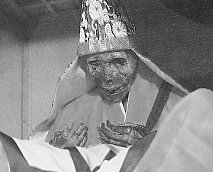
© PHOTO : hosaka
His portrait whilst living

© PHOTO : yamagata/uzen
. . . CLICK here for more Photos !
Temple Chuuren-ji 注連寺 (Churenji)
Churen-ji is the resting site of yet another sokushinbutsu, the natural embalming processed being accomplished by abstaining from all grains and eating only tree and grass foods.
There are many tales surrounding the Edo Era individual who eventually became the mummy here; he is said to have killed two samurai over women problems and escaped to Churen-ji, where he became a mountain ascetic.
After enduring many harduous rituals in the nearby mountains he made great efforts to rebuild the temple. At the age of 54 he visited Edo where he saw the great extent of eye illnesses, a major infliction at the time. This moved him to take out his own eye (the left) and throw it into the Sumida-gawa (Sumida River) and pray for a cure to the eye illnesses of the masses. What happened to the eye is not recorded, however, in 1829 in front of many believers he entered the main hall of Churen-ji where he attained living Buddhahood.
http://www4.ocn.ne.jp/~yuko2000/shonai-r/asahi/sh/churen-ji.html
His hands as a print. (picture 04)
Drawing of a Dragon-Circle by him. (picture 05)
:::::::::::::::::::::::::::::::::::::::::::::::::::::::::::::::::::::::::::::::::::::::::::::::::::::
Honmyookai Shoonin 本明海上人, Temple Honmyoo-ji
Honmyokai Shonin
If you believe in his power, your mental problems will be healed and your eyes will be sharp forever. He is sitting in the temple Honmyoo-ji 本明寺.
. . . CLICK here for Photos !
:::::::::::::::::::::::::::::::::::::::::::::::::::::::::::::::::::::::::::::::::::::::::::::::::::::
Tetsuryuukai Shoonin 鉄竜海上人
Disciple of Tetsumonkai. Tetsuryukai Shonin
at the temple Nangaku-ji 南岳寺

© PHOTO www.tsuruokakanko.com
南岳寺 鶴岡市砂田町3-6
. . . CLICK here for Photos !
He passed on in 1868, on the 8th of the 8th month、at the age of 62 years.
:::::::::::::::::::::::::::::::::::::::::::::::::::::::::::::::::::::::::::::::::::::::::::::::::::::
Chuukai Shoonin 忠海上人 and
Enmeikai Shoonin 円明海上人
Both were priests at the temple Kaikoo-ji 海向寺.
. . . CLICK here for Photos !
Chuukai passed away in 1755 and Enmeikai in 1822. This is the only temple which has two mummies.
Grave of Enmeikai (picture 07)
:::::::::::::::::::::::::::::::::::::::::::::::::::::::::::::::::::::::::::::::::::::::::::::::::::::

Bukkai Shoonin 仏海上人
Temple Kannon-ji 観音寺
He found his end in the Meiji period, when officially this practise was abolished. After visiting the mummies of 18 other “predecessors”, he passed away in the year Meiji 36, on the 20th of March. He was the last one to follow this tradition of asceticism.
利剣名号信仰
See his stone memorial and the character BUTSU, Buddha in a special script.
At the temple Kichijoo-ji 吉祥寺 there are 100 statues of Jizoo Bosatsu, engraved by Bukkai Shoonin. (picture 08)
:::::::::::::::::::::::::::::::::::::::::::::::::::::::::::::::::::::::::::::::::::::::::::::::::::::
Zenkai Hooshi 全海法師
松井山観音寺

© PHOTO : hosaka
He lived from 1602 till 1687. He started his practise of eating bark (mokujiki) in 1684.
A special festival in his favor is held on the 8th day of July and on the 8th of September. The whole village celebrates at the temple Kannon-ji.
. . . CLICK here for Photos !
:::::::::::::::::::::::::::::::::::::::::::::::::::::::::::::::::::::::::::::::::::::::::::::::::::::
Shuukai Shoonin 秀快上人
Temple 真珠院
He was born in 1719 and entered the last position in 1780. He practised his asceticism at the Hase-temple in Kyoto. Now he is in Niigata prefecture.
The temple hall 入定堂 has a beautiful ceiling of painted squares.
. . . CLICK here for Photos !
:::::::::::::::::::::::::::::::::::::::::::::::::::::::::::::::::::::::::::::::::::::::::::::::::::::

Shinsoo Gyoojun Daigyooja, Shinshuu Gyoojun
心相行順大行者, 心宗行順大行者
Kubota Hikosaemon 久保田彦左衛門
His mummy is open for the public twice a year during public holidays, on the 29th of April and the 15th of September. On a festival in his honour villagers race around in sandals made of heavy iron and parade around the village.
09 picture of his mummy, clad in a blue robe
10 picture of his grave stone
:::::::::::::::::::::::::::::::::::::::::::::::::::::::::::::::::::::::::::::::::::::::::::::::::::::
Myooshin Shoonin, Myoshin Shonin 妙心上人
(picture 11 : his mummy, almost naked)
He was born in 1718 in Yokokura and passed away in 1815 in Yamanashi.
He spend most of his time leading pilgrims on to Mt. Fuji. He was brought back to his hometown during the Meiji period and is now seated in the Tempel Yokokuradeera in Gifu prefecture.
舎利堂
. . . CLICK here for Photos !
両界山横蔵寺Ryokaizan Yokokura-ji
:::::::::::::::::::::::::::::::::::::::::::::::::::::::::::::::::::::::::::::::::::::::::::::::::::::
Tanzei Shoonin 弾誓上人
. . . CLICK here for Photos !
He started his bark eating (mokujiki) around 1600. His statue is now in the temple Amida-ji in Kyoto.
His statue made of cedar wood (hinoki) statue is quite famous. It is 75 cm hgh and he is shown in his priest robes (noo-e).
西善寺, 弾誓寺観音堂
12 picture of his statue, a national treasure (bunkazai)>
13 picture Some pictures of the caves where he practiced ascetism.
. Mokujiki 木喰上人 / 木食 "eating wood" asceticism - Introduction - .
Carver 木食明満 Mokujiki Myoman / Mokujiki Gogyō 木喰五行 Gogyo
(1718 - 1810) - and many others
:::::::::::::::::::::::::::::::::::::::::::::::::::::::::::::::::::::::::::::::::::::::::::::::::::::
The Buddhist icon and the modern gaze
by Bernard Faure
Quote:
The famous mummy of Hui-Neng, the Zen patriarch in China
. . . CLICK here for Photos of Hui-Neng!
Sometimes Buddhist mummies, too, were used just like icons, as when the "flesh-body" of the Chan patriarch Huineng (d. 713) was paraded through town on a palanquin in times of drought, as a substitute for the icon of the Bodhisattva Guanyin.
The description of this "celebrated monster" given by Jesuit missionaries suggests that, like popular icons, this mummy had been blackened by the smoke of incense.(48) This raises the question of whether this flesh-body is the same as the lacquered, golden-colored mummy that was until recently visible at the Nanhua Monastery near Canton.
Click HERE for photos.
Another famous carver-priest
Daruma Pilgrims in Japan: Enku (Enkuu) 円空
Daruma Pilgrims in Japan: Haguro San 羽黒山
.......................................................................
Marathon Monks at Mt. Hiei
This is a practise still presersved today.
1000 Days Walking and Praying around Mt. Hiei at Kyoto

The Kaihōgyō (回峰行) (circling the mountain)
is a set of the ascetic spiritual trainings for which the Buddhist "marathon monks" (a term coined by John Stevens) of Mt. Hiei are known. These monks are from the Tendai school of Buddhism, a denomination brought to Japan by the monk Saichō in 806 from China.
- - - More in the WIKIPEDIA !
. 建立大師相応和尚 Konryu Daishi So-O Kasho .
(833 - 918) Founder of 北嶺回峯行 an Hieizan.
Sennichi Kaihoogyoo 千日回峰行 of the Tendai Sect
The Marathon Monks of Mount Hiei by Dave Ganci
The Marathon Monks of Mt. Hiei: Better than Olympic athletes?
Inside Yokawa Chudo is a mural of Fudo-myo-o, the central deity the gyoja pray to during the kaihogyo 1,000 Day Challenge. They chant his mantra throughout the pilgrimage route.
Fudo-myo protects all living beings and helps them reach enlightenment by burning away their impediments and defilements. He is also sometimes called the Remover of Obstacles.

- source : Amy Chavez
. Fudō Myō-ō, Fudoo Myoo-Oo 不動明王 Fudo Myo-O
Acala Vidyârâja - Vidyaraja .
:::::::::::::::::::::::::::::::::::::::::::::::::::::::::::::::::::::::::::::::::::::::::::::::::::::
- quote
The Self-Mummified Monks of Yamagata, Japan
There are approximately 24 corpses enshrined in Japanese temples. Many are located in Yamagata Prefecture. They are seated in meditative posture and dressed in sacerdotal robes, as though still alive. In their bony fingers are bells, rosary beads, or other ritual instruments. Some are well preserved, their skeletal structures hidden by darkened skin, and others are mostly bone, with flesh covering only their hands or chest and back.
These individuals were not embalmed. They intentionally mummified themselves over a grueling period of more than ten years. They abstained from cereals and supplemented their diets with unusual substances, including pine needles and bark, herbs, grassroots, butterburs, and small river stones. Pine products function as preserving agents, while natural plants and herbs inhibit bacterial growth (Micozzi & Sledzik, 1992). The practice of swallowing small stones originated in the ascetic, Daoist pursuit of Immortality. Daoists fasted and ingested odd substances, including small stones, in order to stave off the feeling of hunger (Eskildsen, 1998).
MORE
- source : yahoo.com/the-self-mummified-monks-yamagata
Modern Japanese Research in the subject
山形県鶴岡市出羽三山(羽黒山・月山・湯殿山など とミイラ仏
http://homepage2.nifty.com/mono-gaku/gassyuku.htm
:::::::::::::::::::::::::::::::::::::::::::::::::::::::::::::::::::::::::::::::::::::::::::::::::::::
The subject of self-moritifcation is of course rather fascinating, even for modern man. There have been quite a few TV dramas and detective stories about these mummies. Even manga with these subjects are quite popular.
高橋克彦「即身仏の殺人」
(文春文庫)
:::::::::::::::::::::::::::::::::::::::::::::::::::::::::::::::::::::::::::::::::::::::::::::::::::::
H A I K U
みいらともなりたがりてやはつ日の出
miira to mo naritagarite ya hatsuhi no de
I wish to become
a living mummy too ...
first sunrise (of the new year)
Kobayashi Issa 一茶
Tr. Gabi Greve
:::::::::::::::::::::::::::::::::::::::::::::::::::::::::::::::::::::::::::::::::::::::::::::::::::::
冷まじや哄ふ如くに木乃伊仏(みいらぶつ)hiemaji ya warau gotoku ni miirabutsu
such a cold -
it looks like laughing loud
this living mummy
source : masuhiro, 2002
Tr. Gabi Greve
:::::::::::::::::::::::::::::::::::::::::::::::::::::::::::::::::::::::::::::::::::::::::::::::::::::
Through the Cloud Gate to Moon Mountain:
A Journey in OkuTim Hornyak Tokyo, Japan
I woke to the sight of a steel-blue Sea of Japan to my left under the white wing of the 8:05 JAL out of Haneda. We were flying low, descending over a tatami floor of yellow and green - the rice fields of Akita. They are legend in Japan, I recalled, the Komachi strain honoring Ono no Komachi, the Heian beauty and poet said to have been the scion of this verdant northern backwater of the archipelago. Sucking in the pure Tohoku morning air on the ground, I could see it was harvest time here in Yuwa town, far from Tokyo. The plants were lying down in the fields, heavy with seed. I thought of the adage:
Minoru hodo koube o tareru inaho kana
The more they ripen,
the lower they bow their heads
the ears of rice
These paddies also produce the main ingredient for some of the finest sake in Japan, and the depths of snow that cover them in winter is responsible, they say, for the lustrous white skin of Akita bijin, as the local belles are known. I could see a difference in the faces of the Japanese at the World Haiku Festival venue near the airport, my first destination in the north country. They had broader bone structure, were taller and somehow more solid than the inhabitants of the capital.
Their protocol was more substantial as well. A reception for the foreign conference guests was held at the restaurant Villa Flora on a hill overlooking a valley of rice. The Yuwa councilmen, our hosts, were decked out in blue suits, Brylcreem hair and thick-rimmed glasses. An emcee announced when the party would begin and end, speeches were made by the mayor and representatives of several haiku clubs. There were entertainments of traditional Akita songs with drum, shakuhachi and samisen accompaniment as well as dancing by middle-aged women in kimono.
We were asked to recite a haiku of our own composition, and I recalled visiting Basho's birthplace in Mie Prefecture a month earlier; Iga-Ueno was known as one of the two main centers for ninja, and before taking in a museum on the medieval assassins I had stopped at Basho's home. The large reconstructed main building seemed out of character with my image of the wayfarer, but nestled among the banana plants in the yard was his writing hut, which he called Chougekken -- literally, "Fishing Moon House". A nail dangled country footwear by the bare mats, and I pictured him composing after weeks on the road:
Straw sandals hanging
tatami by tatami...
tools to catch the moon
The bus to Kisakata, the following day, took us through emerald glens. Someone said Basho allegedly embarked on his Oku no Hosomichi odyssey because he was really a ninja and was on an intelligence-gathering mission for the Tokugawa shogunate. I laughed at the thought of a ninja weeping, as the sentimental poet often described himself doing.
Studded with pine, the "islands" of Kisakata were floating on a golden sea of rice in the sun. The 1804 earthquake that destroyed the lagoons had also replaced the cranes of Basho's day with crows. It was almost a Van Gogh painting. Amid the knolls, we could see hooded country women gathering rice cuttings and binding them to poles called haza. These looked like a row of people in traditional straw raincoats, the kind Basho and Sora wore while negotiating the muddy tracks. I later wrote the following:
Rice drying on poles...
a line of ancient pilgrims
frozen in the field
We were taken to Meiji poet Ishii Rogetsu's grave at a small hillside temple. Graveyards in Japan have always fascinated me; their wooden touba markers inscribed with Buddhist death-names, regular cleansing rituals, food and floral offerings. One cinerarium seemed a hive of life.
Withered offerings
bees crawl into cracks
in the family grave
That night, we held a moon-viewing party to honor the harvest moon. A bottle of the finest Akita sake, Hiraizumi, was brought along with pampas grass and other tokens. Our cheers finally coaxed it from behind a shroud of cloud, whereupon a toast was made. Later I repaired to a dark wooded patch away from the hotel lights and looked up; that magnificent moon seemed to be eyeing me through its veil.
Lying in long grass
I taste the harvest full moon
in my sake cup
I still had moon on the brain when I boarded an express train the next day for Tsuruoka, down the coast. I had long wanted to climb holy Gassan (Moon Mountain) in Yamagata, not because Basho had been there, but because of its association with the famed swordsmiths who lived on it and took the peak's name. They continue to practice their ancient art, as I learned when I once interviewed Nara sword maker Sadatoshi Gassan, the fifth generation of smiths since the Gassan school was relocated to Osaka around 1830. Their accumulated expertise is reflected in the master's prized blades, which seem living worlds in steel-silver dragons coiled around flowering plum trees, pearls floating over milky mists and the Chinese characters for "moon" and "mountain" engraved on the tang as a finishing touch.
I thought of the designs on the razor-sharp katana as I climbed the long stair through centuries-old cedars and mist to the summit of Mt. Haguro. The smith's lineage goes back about 800 years to the Kamakura Period, when Buddhist monks in the ascetic Shugendo sect needed swords to protect their disciples here, one of the three sacred peaks of Dewa Sanzan along with Gassan and Mt. Yudono -- said to represent birth, death and rebirth respectively. Sweating in the cold air, I reached the top of the stair at the shrine complex. The physical world seemed to dissolve at the gate.
Vermilion torii...
beyond it nothing
but mist
They say a handful of yamabushi mountain priests continues to live on Haguro year-round, but I saw none. The museum had an exhibit of round bronze mirrors that abbots of old placed in a local pond as a sign of dedication; its one ancient Gassan sword was not on display. I enjoyed a burst of sunshine in a garden of Jizo statues, pathetically dressed in unkempt layers of clothing to console the spirits of aborted fetuses, then caught one of the last buses of the year to Gassan.
The mist thickened as we climbed into wind and rain. When I got off at the Eighth Station, a gale was raking the volcano, driving cloud and fog over its chilly northern flank. I had hoped to cover the 8 kilometers to Yudono that afternoon, and with regret decided to wait out the storm in a lodge at Mida-ga-Hara, altitude 1,445 meters. After warming myself by a kerosene stove, I set off on a stroll over the marshy plateau through the mist. The alpine gentians were closed, and purple thistles provided the only spots of color in the shadowless grey-green void. I thought of Basho passing here before me, "through the cloud gate into the courses of the sun and moon."
Cold moor pool
grasses beneath the surface
move with the wind
The mist, confusing the visible and invisible, causing the mountainside to appear and disappear, hovered over the ponds like a spirit. I thought it was playing tricks on me when I saw two white, ghostly figures in the distance. As I approached, I could see they were sitting in the lotus posture and looking off into the moor, motionless in the rain. Were these phantoms of smiths who had tempered their swords in holy water, or shades of Yudono ascetics who fasted to death to become mummies? In the moment before I realized they were pilgrims practicing austerities, I felt as though I had passed through a gate into a Moon Mountain spirit-world where time itself does not pass.
Women chanting sutras
had seemed Buddhas from far
on misty Gassan
The storm didn't let up and I never did reach the summit. I accepted an offer of a lift back to Tsuruoka the next day from a worker at the lodge. The sun was shining in the valley below as we drove under the massive torii at the foot of Haguro. Behind us was Gassan, rising out of the cedar forests and vanishing into cloud.
quote from
World Haiku Review 2002
:::::::::::::::::::::::::::::::::::::::::::::::::::::::::::::::::::::::::::::::::::::::::::::::::::::
. San hikoyama 三彦山 three famous HIKO mountains .
[ . BACK to WORLDKIGO . TOP . ]
[ . BACK to DARUMA MUSEUM TOP . ]
- #sokushinbutsu #mummies #livingmummies -
:::::::::::::::::::::::::::::::::::::::::::::::::::::::::::::::::::::::::::::::::::::::::::::::::::::






